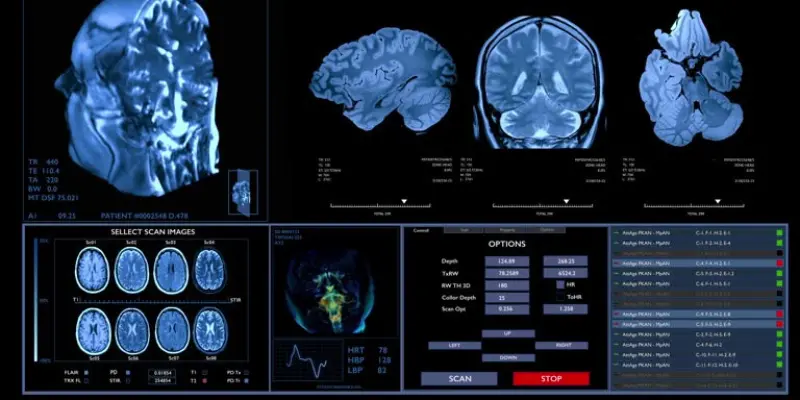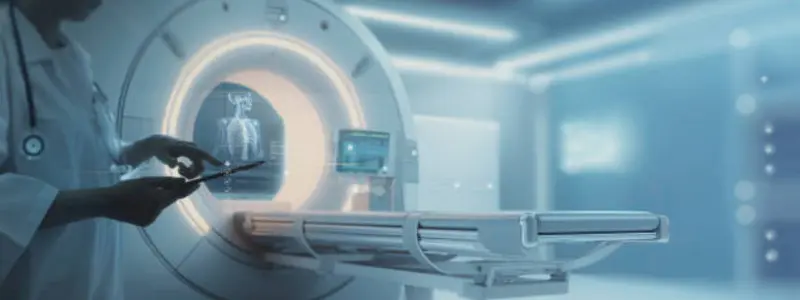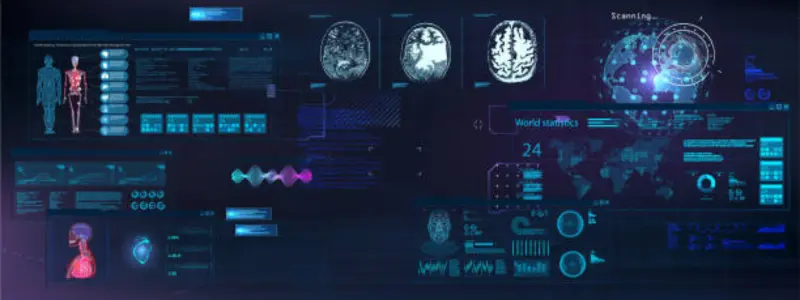AI Services for Radiology, Pathology & Imaging: Smarter Diagnostics for Better Care
Published: 2 Jun 2025
AI in healthcare sounds exciting but also confusing. Many doctors, lab technicians and hospital teams aren’t sure what it really does. Is it just another buzzword? Will it replace experts? Or can it actually help?
Here’s the truth: AI isn’t here to take over—it’s here to assist. Think of it like a smart helper that reads scans, spots problems and supports decisions. It does not replace radiologists or pathologists. Instead, it works with them to make diagnosis faster and more accurate.
Real-life fact: A study from The Lancet Digital Health showed that AI detected breast cancer in mammograms with 94.5% accuracy, even spotting tiny tumors that doctors missed. That’s not magic. That’s AI doing its job well.
In this post, you will learn how AI services are helping in radiology, pathology and medical imaging.

What Is AI in Healthcare Diagnostics?
AI stands for Artificial Intelligence. It means using smart computer programs that can learn from data and make decisions just like humans but faster.
In healthcare diagnostics, AI looks at things like X-rays, MRI scans or tissue samples. It finds patterns, compares them with known diseases and helps doctors spot problems early.
You can think of AI as a trained assistant. It does not guess. It learns from thousands, even millions of medical images to give helpful suggestions.
How It Works
Imagine you have a folder full of chest X-rays. Some of them show pneumonia. Others look normal. A doctor can tell the difference after years of experience.
AI does something similar. It studies thousands of X-rays, learns what pneumonia looks like and then helps to find it in new scans very quickly in seconds.
It’s like Google Photos recognizing faces in your pictures but here, it’s spotting health issues in medical scans.
Why It Matters in Diagnostics
- Doctors face huge workloads and tight deadlines
- Mistakes or delays can hurt patients
- AI helps by catching issues early and saving time
Instead of going through hundreds of slides or images alone, doctors can now work with AI tools to make faster, smarter choices.
AI in Radiology
Radiology is the branch of medicine that uses medical imaging to see inside the body. These images help doctors check for injuries, diseases or anything unusual.

Common imaging tools include:
- X-rays – to view bones, lungs and teeth
- CT scans – for detailed cross-sections of organs
- MRI – to look at soft tissues like the brain or spine
- Ultrasound – often used in pregnancy or organ checks
Radiologists are the experts who read these images and tell doctors what they see. But reading hundreds of scans a day is tough, even for skilled eyes.
How AI Supports Radiologists
AI helps by analyzing medical images quickly and flagging anything that looks abnormal. It does this by:
- Learning from thousands of labeled scans
- Spotting patterns or signs that look like disease
- Marking the image to show where the problem might be
It’s like giving radiologists a digital assistant who never gets tired.
Here’s how AI helps in real life:
| Task | How AI Helps |
| Checking for lung nodules | Highlights tiny spots doctors might miss |
| Comparing scans over time | Spots changes in size, shape or location |
| Emergency triage | Alerts doctors to serious cases faster |
| Report generation | Suggests draft findings to save time |
This does not mean AI replaces doctors. Instead, it makes their work faster and more accurate.
Real-Life Example: Detecting Lung Disease Faster
A hospital in South Korea used an AI system called Lunit INSIGHT CXR to check chest X-rays for signs of lung disease.
- The AI scanned over 3 million X-rays
- It detected problems like pneumonia and tuberculosis in seconds
- It helped doctors cut diagnosis time by up to 30%
This meant patients started treatment sooner, especially in emergencies where every minute counts.
Why AI Is a Game-Changer in Radiology
Let’s break down the main benefits:
Faster Diagnosis
AI can scan images instantly and push urgent cases to the top of the review list.
Improved Accuracy
It spots small details that even skilled eyes might miss after a long shift.
Better Workload Management
Doctors get support on routine tasks and can focus more on complex cases.
Early Detection = Better Outcomes
Finding diseases early means treatment starts sooner and that can save lives.
Tip: Start Small and Scale Slowly
If you manage a hospital or diagnostic lab, here’s a tip:
Start AI with one imaging task. Try it for chest X-rays or brain CT scans. Monitor results, gather feedback and see if it saves time or improves accuracy.
Then, expand to more services when your team feels confident.
AI in Pathology
Pathology is a special part of medicine where doctors study tiny samples of tissue, blood or cells to find out what’s happening inside the body. Pathologists use microscopes to look very closely at these samples.
Pathologists study these samples under a microscope to spot things like:
- Infections
- Cancer cells
- Inflammation
- Cell damage
Their job is to find signs of illness such as infections, cancer or damaged cells. This work helps doctors understand exactly what’s wrong with a patient so they can decide on the right treatment.
Why Pathology Needs AI
Traditional pathology is very careful but also slow and sometimes tiring. Pathologists often have to review hundreds of slides every day and the tiny differences between healthy and sick cells can be hard to see. This is where AI can help a lot. AI can quickly scan thousands of digital images of tissue samples and highlight parts that look unusual or suspicious. This support means that pathologists can focus more on the important parts and make better decisions faster. AI acts like a smart helper that keeps working without getting tired or distracted, improving the speed and accuracy of diagnoses.

How AI Works in Pathology
AI in pathology uses a process called digital pathology. Here’s how it works step-by-step:
- A lab technician scans tissue slides into high resolution images
- The AI tool analyzes the images pixel by pixel
- It flags unusual shapes, colors or clusters that may be signs of disease
- The pathologist checks the flagged areas and makes the final diagnosis
This makes the process faster, more accurate and easier to repeat.
Key Benefits of AI in Pathology
| Benefit | What It Means for Labs and Patients |
| Higher accuracy | Fewer missed diagnoses |
| Faster results | Patients get answers sooner |
| Less human error | Better focus and fewer mistakes in long shifts |
| Better research tools | AI can track patterns over thousands of samples |
Also Read: How AI can Help in Sex Change
Real-Life Example: AI and Cancer Detection
A powerful example comes from breast cancer detection in the United States. Researchers trained AI systems to study digital images of breast tissue samples. The AI was able to detect early signs of breast cancer with over 92% accuracy which is a huge help for doctors.
It flagged cancer cells that were sometimes too small or subtle for even experienced pathologists to see right away. This faster, more accurate detection means patients get their diagnosis sooner which can lead to earlier treatment and better outcomes. The AI also helped reduce false negatives, meaning fewer cases where cancer was missed, which can be life-saving.
Tip: Use AI for Complex or Repetitive Lab Work
If your lab processes many slides every day, AI can take over repetitive, routine checks. For example, AI is very helpful in reviewing cancer biopsies, screening Pap smears or analyzing blood smears. These tasks involve looking for very specific signs over many samples which can be exhausting and prone to mistakes when done manually. By letting AI handle these parts, your pathologists can spend more time on complex cases and critical thinking. This way, AI acts as a trusted assistant that improves both efficiency and quality in your lab.
AI in Medical Imaging
Medical imaging combines different technologies to create pictures of the inside of the body. This includes X-rays, MRIs, CT scans and ultrasounds. These images help doctors understand what’s going on without surgery. It’s like getting a clear map of a city before planning a trip. Doctors use these images to find broken bones, tumors, infections and other health problems. But reading all these images takes time and focus.
How AI Enhances Medical Imaging
AI brings speed and precision to medical imaging. It can analyze large numbers of images fast and highlight anything unusual. This makes it easier for doctors to spot problems early.
Here are some ways AI helps in medical imaging:
- Automated Image Analysis: AI quickly reviews images and points out areas of concern.
- Pattern Recognition: It recognizes disease patterns by comparing images with large datasets.
- Prioritizing Cases: AI can rank urgent cases so doctors review the most critical ones first.
- 3D Image Reconstruction: AI helps to create detailed 3D views from scans, improving diagnosis.
This support helps to reduce mistakes and speeds up patient care.

Real-Life Example: Stroke Detection with AI
Stroke treatment depends on fast diagnosis. A hospital in the U.S. used an AI tool to read CT scans and detect strokes.
- The AI flagged strokes in under 5 minutes.
- It helped doctors start treatment faster, improving patient recovery chances.
- Faster detection reduced delays in emergency rooms.
This example shows how AI can save lives by speeding up diagnosis in emergencies.
Benefits of AI in Medical Imaging
Using AI in medical imaging offers many advantages:
- Faster Results: AI speeds up image review, cutting waiting times.
- Improved Accuracy: It reduces human errors, especially in subtle or complex cases.
- Workload Support: Helps radiologists handle heavy workloads without burnout.
- Better Patient Outcomes: Early and accurate diagnosis leads to better treatments.
Tips for Implementing AI in Medical Imaging
If your healthcare facility plans to add AI, consider these steps:
- Start with a pilot project focusing on one type of imaging like CT scans.
- Train your team on how AI tools work and how to interpret AI results.
- Use AI as a support tool not a replacement for doctors.
- Monitor outcomes and gather feedback regularly to improve processes.
Emerging Trends and Challenges in AI for Healthcare
AI is a rapidly evolving field, especially in healthcare it brings new trends very quickly. Let’s take a quick look at the new innovations AI can bring in healthcare.
What’s New in AI for Healthcare?
AI technology keeps getting better and smarter. New tools are changing how doctors diagnose and treat diseases. Here are some exciting trends:
- AI-Powered Wearables: Devices like smartwatches now track heart rate, oxygen levels and even detect irregular heartbeats in real time. This helps in catching problems early at home.
- Personalized Medicine: AI analyzes your unique health data to suggest treatments that fit your body and lifestyle. It’s like a custom health plan just for you.
- AI Chatbots: Virtual assistants help to answer patients’ questions, schedule appointments and remind people about medication, making healthcare easier to access.
- Integration Across Systems: AI connects data from labs, imaging and electronic health records, giving doctors a fuller picture of a patient’s health.
These trends show how AI is becoming part of everyday healthcare, hereby improving care quality and access.
Challenges AI Faces in Healthcare
Despite the benefits, there are certain problems with AI in healthcare to address and overcome:
- Data Privacy: Patient data is sensitive. Keeping it safe and private is a top concern.
- Bias in AI Models: AI learns from past data. If that data is incomplete or biased, AI can make unfair decisions. For example, it might work better for some groups than others.
- Cost and Access: Advanced AI tools can be expensive, limiting access for smaller clinics or developing regions.
- Regulation and Trust: Doctors and patients need to trust AI tools. Clear regulations and testing are needed to ensure safety and reliability.
- Training Healthcare Staff: Medical teams need proper training to use AI effectively. Without it, tools might be underused or misunderstood.
Tips to Overcome These Challenges
If your healthcare organization wants to adopt AI, here are some helpful tips:
- Focus on Data Security: Use strong encryption and follow healthcare privacy laws like HIPAA.
- Choose Diverse Data: Make sure AI tools are trained on data from different populations to reduce bias.
- Start Small: Test AI tools in one department before rolling them out widely.
- Educate Staff: Train doctors, nurses and technicians on how to use AI tools and interpret their results.
- Work with Regulators: Keep up to date with healthcare regulations and certifications for AI devices.
How to Choose the Right AI Service
Choosing the right AI service for radiology, pathology and imaging can feel tricky. Here’s a simple checklist to help you pick the best one for your healthcare needs:
➤ Simple Checklist
- Is the company trusted in healthcare?
Look for providers with a strong reputation and experience working with hospitals or clinics. Trust matters when it comes to patient care. - Does it offer support and training?
AI tools are new to many teams. Good companies provide easy training and ongoing support to help your staff use AI confidently. - Has it been used in real hospitals?
Ask for case studies or proof that the AI service works in real world settings. This shows the tool is tested and reliable.
➤ Suggestion
Before you invest, always ask for a free demo or trial. Trying the AI service yourself helps you see how it fits with your workflow and if it meets your needs.
Conclusion
AI is changing the way healthcare works. In radiology, pathology and medical imaging, AI helps doctors make faster and smarter diagnoses. This means patients get better care, sooner. While AI is powerful, it works best when combined with skilled doctors and trusted tools.
Choosing the right AI service takes careful thought. Look for trusted healthcare AI companies, good support and proven results. Remember, AI is here to help not replace the experts who care for us.
Are you ready to explore AI services that can improve your healthcare practice? Taking the first step today can lead to smarter diagnostics and better patient outcomes tomorrow.
Common Questions About AI in Services in Radiology and Pathology
Here frequently asked questions about AI services in radiology and pathology:
AI diagnostic tools can range from $10,000 to $100,000+ annually depending on features and patient volume. Many companies offer subscription models that scale with usage, making it more affordable for smaller practices. Some cloud-based solutions start as low as $500-1,000 per month for basic imaging analysis.
AI tools are designed as assistants, not replacements for doctors, so the final diagnosis always comes from a qualified physician. Most AI systems include confidence scores and highlight uncertain areas for human review. Legal responsibility still lies with the healthcare provider and malpractice insurance typically covers AI-assisted diagnoses.
Basic AI tool training usually takes 1-2 weeks for most medical staff. Advanced features might require 1-2 months of practice to master fully. Most AI companies provide ongoing support, online tutorials and certification programs to help the staff become proficient.
Most modern AI solutions are designed to integrate with common hospital systems like PACS (Picture Archiving Systems) and electronic health records. However, older equipment may need updates or adapters to connect properly. It’s important to check compatibility before purchasing any AI service.
Many AI tools now offer offline capabilities or local processing options for areas with poor internet connectivity. Cloud-based solutions typically need stable broadband but some companies provide hybrid systems that work locally. Edge computing solutions are becoming more common for remote locations.
Most AI systems provide detailed analytics showing detection rates, time savings and accuracy improvements compared to baseline performance. You can track metrics like reduced false negatives, faster turnaround times and patient outcome improvements. Regular audits and comparison studies help to measure real-world effectiveness.
AI currently performs best in image-heavy specialties like radiology, dermatology, ophthalmology and pathology where pattern recognition is crucial. It’s also effective in cardiology for ECG analysis and emergency medicine for triage. Specialties requiring more human interaction and complex reasoning may see slower AI adoption.
AI systems typically need access to medical images, relevant patient history and sometimes lab results to provide accurate analysis. Data is usually encrypted and stored according to HIPAA and other privacy regulations. Many systems use anonymized data and local processing to minimize privacy risks.
AI can be particularly valuable for rare diseases because it can be trained on global databases of uncommon conditions. It can flag unusual patterns that might remind doctors to consider rare diagnoses they haven’t seen before. However, AI for rare diseases is still developing and may require specialized training datasets.
Start with voluntary pilot programs and involve early adopters who can demonstrate benefits to skeptical colleagues. Provide clear evidence of how AI saves time rather than creating extra work. Focus on showing how AI enhances their expertise rather than replacing it and ensure adequate training and support during the transition.





